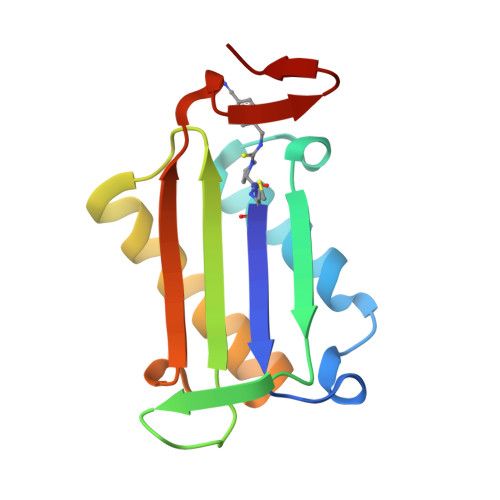Structural basis for decreased induction of class IB PI3-kinases expression by MIF inhibitors.
Singh, A.K., Pantouris, G., Borosch, S., Rojanasthien, S., Cho, T.Y.(2017) J Cell Mol Med 21: 142-153
- PubMed: 27619729
- DOI: https://doi.org/10.1111/jcmm.12949
- Primary Citation of Related Structures:
4Z15, 4Z1T, 4Z1U - PubMed Abstract:
Macrophage migration inhibitory factor (MIF) is a master regulator of proinflammatory cytokines and plays pathological roles when not properly regulated in rheumatoid arthritis, lupus, atherosclerosis, asthma and cancer. Unlike canonical cytokines, MIF has vestigial keto-enol tautomerase activity. Most of the current MIF inhibitors were screened for the inhibition of this enzymatic activity. However, only some of the enzymatic inhibitors inhibit receptor-mediated biological functions of MIF, such as cell recruitment, through an unknown molecular mechanism. The goal of this study was to understand the molecular basis underlying the pharmacological inhibition of biological functions of MIF. Here, we demonstrate how the structural changes caused upon inhibitor binding translate into the alteration of MIF-induced downstream signalling. Macrophage migration inhibitory factor activates phosphoinositide 3-kinases (PI3Ks) that play a pivotal role in immune cell recruitment in health and disease. There are several different PI3K isoforms, but little is known about how they respond to MIF. We demonstrate that MIF up-regulates the expression of Class IB PI3Ks in leucocytes. We also demonstrate that MIF tautomerase active site inhibitors down-regulate the expression of Class IB PI3Ks as well as leucocyte recruitment in vitro and in vivo. Finally, based on our MIF:inhibitor complex crystal structures, we hypothesize that the reduction in Class IB PI3K expression occurs because of the displacement of Pro1 towards the second loop of MIF upon inhibitor binding, which results in increased flexibility of the loop 2 and sub-optimal MIF binding to its receptors. These results will provide molecular insights for fine-tuning the biological functions of MIF.
- Edward A. Doisy Department of Biochemistry and Molecular Biology, Saint Louis University School of Medicine, St. Louis, MO, USA.
Organizational Affiliation:


















